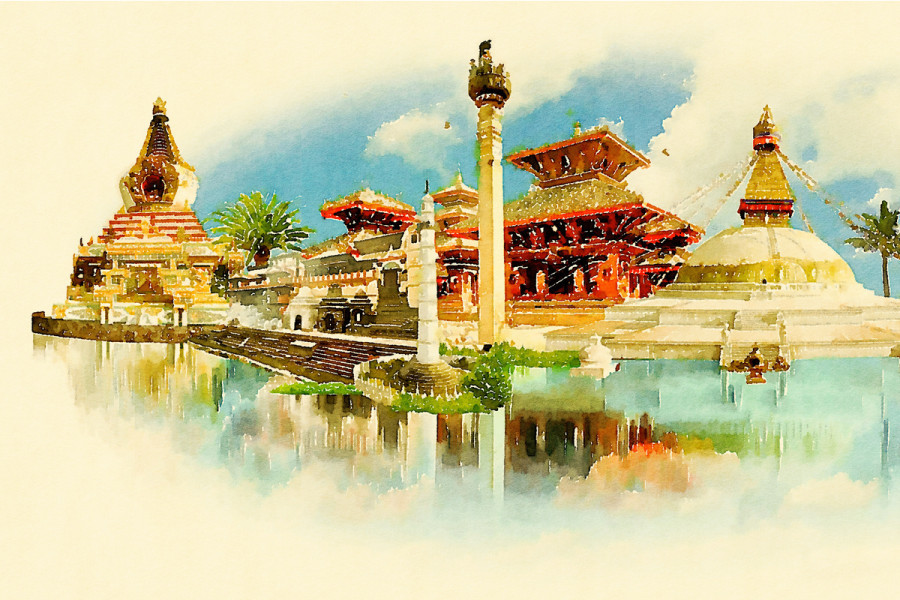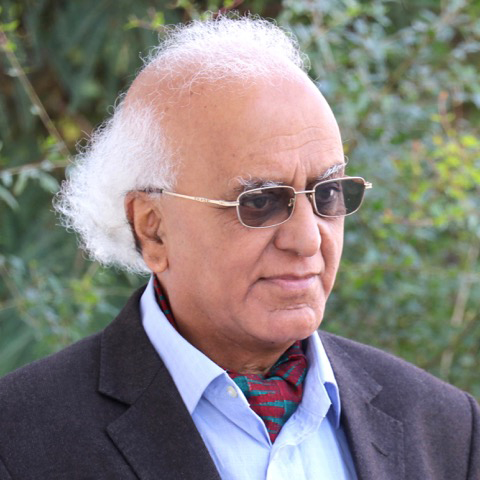Columns
Poetic ecology of Nepal Mandala
The pristine ecology of the valley that poets of yesteryear praised is now losing that state.
Abhi Subedi
This article attempts to discuss the ecology of the Kathmandu Valley by alluding to poetry, heritage, culturally important architectonic sites and the visions of an important visionary. Poets of yesteryear have praised the Valley’s pristine ecology, which is now losing that state.
I begin with some examples of poetic expressions. Poet Bhanubhakta Acharya (1814-66), after a few days' walk from his home village Tanahun, entered Kathmandu through Balaju, which struck him as a paradise. He composed a poem in praise of the place like this: "I saw Balaju today after so many days/ and writing this verse knowing that this is a paradise on earth./ Birds swing on the vines around./ Oh how they draw the mind/ through their sweet melodies".
Poet Laxmi Prasad Devkota (1909-59) has written a brilliant onomatopoetic melody titled "Sundarijal", an unprecedented poetic consonance with ecology. I advise the ecologists to read that poem loudly in groups. Devkota also speaks eloquently about the pristine ecological position of the Kathmandu Valley. We can imagine the then-open landscape covered by dense cities today. The poet describes this section of Kantipur in his poem Sharad or Autumn. He describes the angelic rice fields teeming with "thatched cottages, golden houses… and flowers that opened with poetic abandon. … I feel I hear the water babbling in sleep." And he writes, "If you carefully listen to that you can hear the very flow of the sweet melody of the moon". That has all changed beyond recognition today. Preserving the pristine ecology of a space where you have chosen to make a capital city is impossible.
Poet Siddhicharan Shrestha (1912-92) wrote a famous poem about an eagle serenading in the sky—Antarikshyama chila karayo. These are a few examples that I have cited from my memory and translated. Poets of the later times picture the city as modern, like any other city. There is a difference between the true picture of the ecology of Kathmandu and the emulation of Western avant-gardist drifts. However, I must mention here that the ecology of Nepal Mandala, which is captured in the tangible and intangible heritage, is still there. Very few ecologists have turned their attention to this matter. Though the tangible forms of such heritage are getting lost, we can see a unique blend of the dynamics of the ecology of the Nepal Valley and the tangible heritage sites. I have taken a few examples in the following section.
Kathmandu’s ecology is not an isolated phenomenon. It is a part of global and regional climate change and the pervasive impact of such metamorphosis. Climate seminars, academic sessions and media are full of such tautologies. But our responses to the ecological changes that occur in Kathmandu emanate from our deep anxieties about the sweeping changes in the environmental condition of the valley. What gets commonly left out in the expressions is the significant narrative about the poetic creation of the arts and architecture of the Nepal Valley.
People from fields of culture and literature discuss this subject; they raise concerns about the damage that the cultural artefacts and the architectonic formations have suffered. Some native and foreign writers have studied the relationship between the intangible cultural forms that abound in the valley.
The title of a book written by an Austrian architect and scholar named Carl Pruscha reflects on the environmental concerns with cultural heritage. The title is Kathmandu Valley: The Preservation of Physical Environment and Cultural Heritage. What strikes me about this tome is its rich illustrative presentation of the relationship between cultural heritage and environment. He shows the relationship between the degradation of the physical environment and the structures. This book, when it was published in 1975, surprised people with its comprehensive index of the sites and monuments which were constructed in the Kathmandu Valley.
Pruscha has classified and identified 34 monument zones, 32 preservation districts and 29 "natural preservation districts." He has also identified 888 individual monuments and sites. Thanks to architect Biresh Shah, I attended the 88-year-old Pruscha's discourse given online to people he knew on May 31, 2024, at Taragaon that he had designed. I want to recall here my article "Pruscha's Kathmandu Valley" (The Kathmandu Post, June 12, 2016).
I want to write about the ecology of the Nepal Mandala. Some important works like Gautam Vajracharya's Hanumandhoka Rajdarbar (2033 BS), Sudarshan Raj Tiwari's The Ancient Settlements of the Kathmandu Valley (2011) and Niels Gutschow's Newar Architecture (2011) need close reading. The book by an American scholar, Mary Slusser (1918-2017), who has presented a unique picture of the ecology of this space by blending nature and culture is worth mentioning. Like many others, this scholar whom I personally knew very well, has written a book titled Nepal Mandala (1982, 1998). Her oeuvre has evoked various responses from both the natives and the non-natives. Mary's Nepal Mandala makes an eloquent study of ecology by brilliantly blending heritage, arts and people.
I want to recall another visceral interpretation of the poetic ecology of the Kathmandu Valley made by Dr Sanduk Ruit, the famous ophthalmologist who, according to Google reports, "was involved in restoring the sight of over 180,000 people across Africa and Asia." He is giving continuity to this activity. Dr Ruit once told me he had never seen such an ecologically friendly place as Kathmandu. He says the Kathmandu ecology has drawn people here and helped them create cultural civilisations and feel comfortable. I remember one other example he gave then. He said Kathmandu does not let you feel extremely exasperated and miserable regarding the ecological condition.
If you are feeling terrible on a sultry day in Kathmandu Valley, all you have to do is wait until the cloud forms and a heavy or light rain pours down. Dr Ruit evoked the poetic and benevolent nature of the ecology of the Valley that remained home to great eco-cultural times. His perception or vision is poetic, human and aesthetic. But it is not complex; it is simple and approachable. I was struck by the poetic ebullience and trust of nature of the eye surgeon and humanist Dr Ruit. He restores people's visions to see that world and not remain in the dark. The scenes of women and men grinning from ear to ear in joy after Ruit restores vision to them have become a happy feature. That's why perhaps he is called “the god of eyesight”.
Lastly, the reality. Kathmandu has to face ecological challenges like other good places. We should face that with poetry, vision and humanism.




 13.12°C Kathmandu
13.12°C Kathmandu















